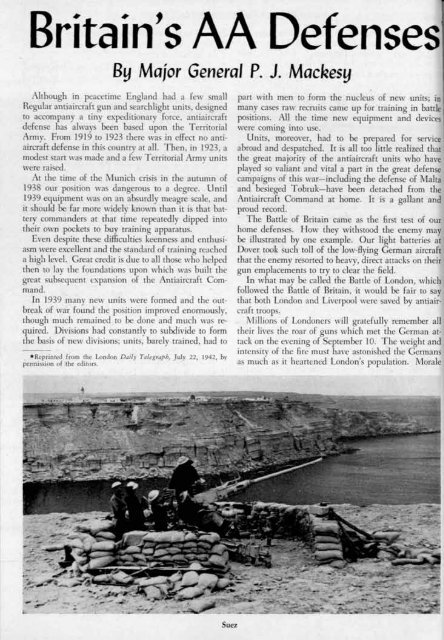January-February - Air Defense Artillery
January-February - Air Defense Artillery
January-February - Air Defense Artillery
Create successful ePaper yourself
Turn your PDF publications into a flip-book with our unique Google optimized e-Paper software.
Britain's AA <strong>Defense</strong>s<br />
By Major General P. J. Mackesy<br />
Although in peacetime England had a few small<br />
Regular antiaircraft gun and searchlight units, designed<br />
to accompany a tiny expeditionary force, antiaircraft<br />
defense has always been based upon the Territorial<br />
Army. From 1919 to 1923 there was in effect no antiaircraft<br />
defense in this country at all. Then, in 1923, a<br />
modest start was made and a f~w Territorial Army units<br />
were raised .•<br />
At the time of the l\'lunich crisis in the autumn of<br />
1938 our position \\'3S d3ngerous to a degree. Until<br />
1939 equipment was on 3n 3bsurdly meagre scale, and<br />
it should be far more widely known than it is that battery<br />
commanders at that time repeatedly dipped into<br />
their own pockets to buy training apparatus.<br />
Even despite these difficulties keenness and enthusiasm<br />
were excellent and the standard of training reached<br />
a high level. Great credit is clue to all those who helped<br />
then to lay the foundations upon which was built the<br />
great subsequent expansion of the Antiaircr3ft Comm3nd.<br />
In 1939 many new units were fonned and the outbreak<br />
of war fo~nd the position improved enormously,<br />
though much remained to be done and much was required.<br />
Divisions had constantly to subdivide to form<br />
the basis of new divisions; units, barely trained, had to<br />
*Reprinted from the London Dail)' Tele/!,raph, July 22, 1942, by<br />
permission of the editors.<br />
Suez<br />
part with men to form the nucleus of new units; in<br />
many cases raw recruits came up for training in battle<br />
positions. All the time new equipment and devices<br />
were coming into use.<br />
Units, moreover, had to be preparecl for service<br />
abroad and despatched. It is all too little realized that<br />
the great majority of the antiaircraft units who have<br />
played so valiant and vital a part in the great defense<br />
campaigns of this war-including the defense of Malta<br />
and besieged Tobruk-have been detached from the<br />
Antiaircraft Command at home. It is a gallant and<br />
proud record.<br />
The Battle of Britain came as the first test of our<br />
home defenses. How they withstood the enemy may<br />
be illustrated by one example. Our light batteries at<br />
Dover took such toll of the low-Bying German aircraft<br />
that the enemy resorted to heavy, direct attacks on their<br />
gun emplacements to try to clear the field.<br />
In what may be called the Battle of London, which<br />
followed the Battle of Brit3in, it would be fair to say<br />
that both London and Liverpool were sayed by antiaircraft<br />
troops.<br />
1\ Iillions of Londoners will gratefully remember all<br />
their lives the roar of guns which met the German attack<br />
on the evening of September 10. The weight and<br />
intensitv of the fire must have astonished the Germans<br />
as much as it heartened London's population. Morale
















